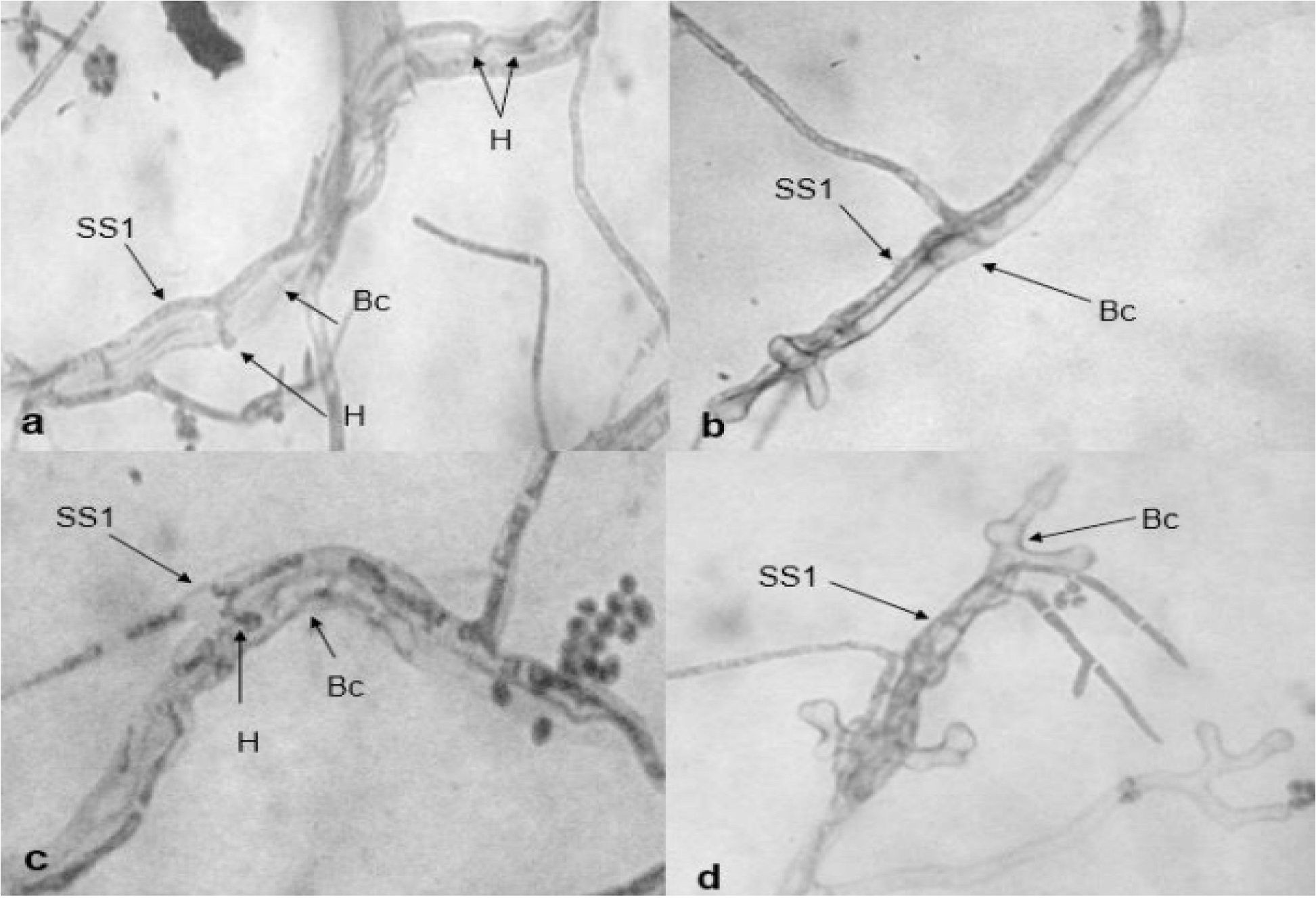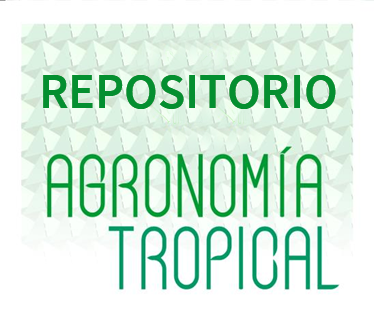Antagonismo in vitro de cepas nativas de Trichoderma spp. contra Verticillium dahliae y Botrytis cinerea en el Estado de México.
Abstract
The cultivation of Rosa sp. it is the ornamental product in greatest demand worldwide. In Mexico, Rosa sp. it represents one of the main ornamentals that is exported. However, diseases represent one of the most serious problems for the production of this crop. The main phytopathogenic fungi that produce losses in yields and quality of the final product are Verticillium dahliae Kleb., and Botrytis cinerea Pers. In previous works, two native strains of Trichoderma spp. were obtained that showed promise for its use in the biological control of Rosellinia necatrix Prill. The present work was carried out with the objective of determining the in vitro antagonism of these strains against V. dahliae and B. cinerea in culture, in the southern region of the State of Mexico. Strains of Trichoderma spp. under study, potato dextrose agar was sown in the culture medium. After seven days of the growth and incubation process of the described fungi, the in vitro mechanisms of action of the antagonist against pathogens were tested. The results showed that all Trichoderma spp. proved to be promising for its use in the biological control of V. dahliae and B. cinerea in the cultivation of Rosa sp., in the southern region of the State of Mexico.
Downloads
References
• Atanasova, L; Le Crom, S; Gruber, S; Coulpier, F; Seidl- Seiboth, V; Kubicek, CP; Druzhinina, IS. 2013. Comparative transcriptomics reveals different strategies of Trichoderma mycoparasitism (en línea). BMC Genomics 14: 121. Consultado 18 ago. 2018. Disponible en https://bit.ly/3cORq2x
• Bell, DK; Wells, HD; Markaham, CR. 1982. In vitro antagonism of Trichoderma species against six fungal plant pathogens (en línea). Phytopatholog y 72:379-382. Consultado 10 dic. 2019. Disponible en https://bit.ly/3lw0TQe
• Benítez, T; Rincón, AM; Codón, AC. 2004. Biocontrol of Trichoderma strains. International Microbiology 7(4) : 249- 260 . Consultado 10 dic . 2020. Disponible en https://bit.ly/3BvHTrX
• Camacho, LMD. 20 0 9. A islamiento de cepas de Botrytis cinerea en el cultivo de Rosa sp. en la zona de Villa Guerrero, Estado de México y la evaluación de su sensibilidad in vitro a fungicidas. Tesis de licenciatura. Centro Universitario UAEM, Universidad Autónoma del Estado de México, Tenancingo. 87 p.
• de los Santos-V illalobos , S; Guzmán - Ortiz, DA ; Gómez-Lim, MA; Délano-Frier, JP; de-Folter, S; Sánchez– García, P; Peña - Cabriales , JJ. 2013. Potential use of Trichoderma asperellum (Samuels, Liechfeldt et Nirenberg) T8a as a biological control agent against anthracnose in mango (Mangifera indica L.). Biological Control 64(1):37-44. Consultado 7 nov. 2019. Disponible en https://bit.ly/3r2WEgh
• Dennise, C; Webster, J. 1971. Antagonistic proper- t i e s o f sp e c i e s g r ou ps o f Tri c ho d erm a : I . Production of volatile antibiotics. Transaction of the British Mycological Societ y 57: 25 -39. Consultado 22 oct. 2018. Disponible en https:// bit.ly/3vFEN2q
• Fernandes, QT; Cardoso, LF; Stecca, SA; Silva, BR; Amorim, JR; Uihoa, CJ. 2013. Mycoparasitism studies of Trichoderma species against three phytopathogenic fungi: evaluation of antagonism and hydrolytic enzyme production. Biotechnology letters 35(9):1461-1468. Consultado 5 may. 2019. Disponible en https:// bit.ly/2WDxpIm
• García-Velasco, R; Alonso, A; Domínguez, G; Aguilar, S; Mora, Martha E; Companioni, B. 2021. Efecto antagónico de cepas nativas de Trichoderma spp. contra el hongo fitopatógeno Rosellinia necatrix en México. Agronomia Tropical. Volumen 71: e4605221:1-15. Consultado 20 mar. 2021. Disponible en https://doi.org/gtg2
• García-Velasco, R; Domínguez, G; Chavarro, EA; Mora, ME. 2017. Pathogenicity of Verticillium dahliae klebahn in rootstock rose cv. Manetti (en línea). APS Anual Meeting, August 5-9. San Antonio, Texas. Consultado 5 may. 2019. Disponible en https://bit.ly/2QbDckz
• García -Velasco, R; González, JG; Domínguez; G; Ayala, V; Aguilar, S. 2012. Rosellinia necatrix en Rosa sp. y su evaluación a sensibilidad de fungicidas (en línea). Revista Chapingo Serie Hor ticultura 18(1): 39-54. Consultado 11 ago.2019. Disponible en https://bit.ly/3rZlGhw
• Harman, G. 2000. Myths and dogmas of biocontrol changes in perceptions derived from research on Trichoderma harzianum T-22 (en línea). The American Phytopathological Society 84(4):377-393. Consultado 10 mar. 2021. Disponible en https://doi.org/dgm942
• Howell, CR. 2003. Mechanisms employed by Trichoderma species in the biological control of plant diseases: The history and evolution of current concepts (en línea). Plant Disease 87(1):4-10. Consultado 11 ago. 2018. Disponible en https://bit.ly/3s7PAjz
• Infante, D; Martínez, B; Gonzáles, N; Reyes, Y. 2009. Mecanismos de acción de Trichoderma frente a hongos fitopatógenos (en línea). Protección Vegetal 24(1): 14-21. Consultado 5 may. 2019. Disponible en https://bit.ly/3DDF7Tt
• Jiménez, DR; Trapero, CJ; Boned, BB; Landa, JA; Navas, C. 2009. Uso de Bioten para la protección biológica de plantones de olivo contra la Verticilosis causada por el patotipo defoliante de Verticillum dahliae. Departamento de protección de cultivos. Boletín Sanidad Vegetal de Plagas 35: 295-615.
• Kenneth, H; Cloyd, A . 2007. Compendium of Rose Diseases and Pests (en línea). Infectious Disease. USA: APS. 5- 40 p. Consultado 11 jul. 2020. Disponible en https://bit.ly/38v24tv
• López, AN. 2019. Efec tividad in vitro de tiaben - dazol sobre Botrytis cinerea Pers. FR. Estado de México: Tesis de licenciatura. Universidad Autónoma del Estado de México Centro Universitario UAEM Tenancingo, 66 p. 86.
• Mackay, C; Franco, Z; Ruiz, K.; González, G; Poveda, G . 2020. El sector florícola ecuatoriano y su afectación en el mercado internacional producto de la pandemia causada por el COVID-19 (en línea). In Rivera-Espinoza, R (ed.). I Congreso Internacional virtual sobre Covid-19. Consecuencias psicológicas, sociales, políticas y económicas. p. 53-65. Consultado 11 jul. 2020. Disponible en https://bit.ly/2Uj935t
• Martínez, TO; Guerrero, BZ; Pecina, V; Rivas, P; González, E; Angelez, JG. 2020. Trichoderma harzianum antagonism against chickpea fusariosis and its biofertilizing effect. Revista Mexicana Ciencias Agrícolas 11(5):1135-1147. Consultado 13 oct. 2020. Disponible en https:// bit.ly/3r7lFa0
• Manzanos , D; López, N; Domínguez, G; García - Velasco, R. 2019. Efectividad in vitro de tiaben- dazol f re nte a Bot r y t is cinére a (e n línea). Revista Mexicana de Fitopatología 37(1): 29. Consultado 13 oct. 2020. Disponible en https:// bit.ly/3kLSwQw
• Martínez, B; Infante, D; Reyes, Y. 2013. Trichoderma spp. y su función en el control de plagas en cultivos (en línea). Protección vegetal 28(1):1-11. Consultado 11 ago. 2018. Disponible en https:// bit.ly/3s4d8pE
• Martínez, M; Nieto, DA ; Teliz, D; Rodrígue z , J; Martínez, MT; Vaquera, H; Carrillo, MO. 2008. Comparación cualitativa de fresas (Fragaria x ananassa Duch) de cultivares mexicanos y estadounidenses (en línea). Revista Chapingo Serie Horticultura 14(2):113-119. Consultado 2 oct. 2019. Disponible en https://bit.ly/317dpfu
• Peláez-Álvarez, A; de los Santos-Villalobos, S; Yépez, EA; Parra-Cota, FI; Reyes-Rodríguez, RT. 2016. Efecto sinérgico de Trichoderma asperellum T8A y C aptan 50® contra Colletotrichum gloeosporioides (Penz.) (en línea). Revista Mexicana de Ciencias Agrícolas 7(6):1401-1412. Consultado 9 jun. 2019. Disponible en https://bit.ly/392udZ
• Pineda - Insuasti, JA; Benavides, EN; Duarte, A S; Burgos, CA; Soto, CP; Pineda, CA; Fierro, FJ; Mora, ES; Álvarez, SE. 2017. Producción de biopreparados de Trichoderma spp: una revisión (en línea). ICIDCA sobre los Derivados de la Caña de Azúcar 51(1):47–52. Consultado 11 may. 2018. Disponible en https://bit.ly/31290ui
• Qualhato, TF; Lopes, FAC; Steindorff, AS; Brandao, RS; Jesuino, RSA; Ulhoa, CJ. 2013. Mycoparasitism studies of Trichoderma species against three phytopathogenic fungi: evaluation of antagonism and hydrolytic enzyme production (en línea). Biotechnology letters 35(9):1461-1468. Consultado 11 ago. 2018. Disponible https://bit.ly/3s3ZyTh
• Rajesh, RW; Shelake, MR; Sabalpar a, AN. 2016. Trichoderma: A significant fungus for agriculture and environment (en línea). African Journal of Agricultural 11(22): 1952-1965. Consultado 11 ago. 2019. Disponible en https://bit.ly/3jznvQE
• Ramírez, RM; Urzúa, HMC; Camacho, CA; Tsuzuki, RG; Esquivel, R. 2015. Técnicas básicas de microbio- logía y su fundamento. Editorial Trillas. México. 375 p.
• Ruiz , R A . 2010. C aptur a, ac tividad biológic a e identif icación de volátiles de la interacción Trichoderma asperellum -Sclerotium rolf sii. Yautepec, Morelos. Tesis de maestría. Centro de Desarrollo de Productos Bióticos, Instituto Politécnico Nacional. México. 136 p.
• Schneider, CA; Rasband, WS; Eliceiri, KW. 2012. NIH Image to ImageJ: 25 years of image analysis (en línea). Nature Methods 9:671-675. Consultado 22 oct. 2019 Disponible en https://doi.org/gcwb4q
• SIAP (Ser vicio de Información Agroalimentaria y Pesquera, México). 2018. Avance de siembra y cosechas resumen por estado (en línea, pág. web). Consultado 11 ago. 2018. Disponible en https://bit.ly/314S06
• SIAV I (Sistema de Información Arancelar ia V ía Internet, México). 2019. Sistema de información arancelaria vía internet. Consultado 22 oct. 2019. Disponible en https://bit.ly/3vMXzFi
• Sivila, N; Jujuy, SA. 2013. Producción artesanal de Trichoderma (en línea). Argentina. Consultado 11 ago. 2020. Disponible en https://bit.ly/3sffS4q
• Villalpando, C; Murillo, B; Zapata, SR; Buerrero, EEF; Monaco, C. 2016. Comparación in vitro de Trichoderma sp. como control biotecnológi de Botrytis cinerea. Avance en energía y medio ambiente 20: 29-36.
• Vinale, F; Marra, R; Scala, F; Ghisalber ti, L; Lorito, M; Sivasithamparam, K . 2006. Major secondary metabolites produced by two comercial Trichoderma strains active against different phytopatogens (en línea). Letters in Applied Microbiology 43(2): 143-148. Consultado 20 ago. 2019. Disponible en https://bit.ly/2V5NLbT
• Xiaojun, C; Wongkaew, S; Jie, Y; Haiyong, H; Shiping, W; Quigqun, T; Buensateai, N; 2014. In vitro inhibition of pathogenic Verticillium dahliae, causal agent of potato wilt disease in China by Trichoderma isolates (en línea). African Journal of Bacteriology 13(33):3402-3411. Consultado 20 jun. 2019. Disponible en https://bit.ly/3DxDsyN
• Youssef, S; Tartoura, K; Abdelraouf, G. 2016. Evaluation of Trichoderma harzianum and Serratia proteamaculans effect on disease suppression, stimulation of ROS-scavenging enzymes and improving tomato growth infected by Rhizoctonia solani (en línea). Biological Control 100:79-86. Consultado 9 may. 2020. Disponible en https://bit.ly/3c8h3fO





